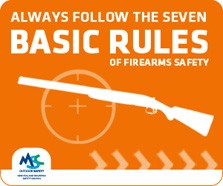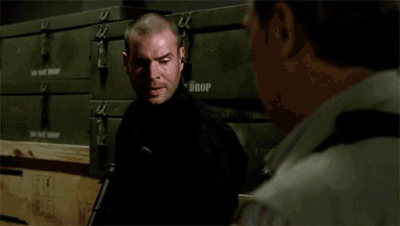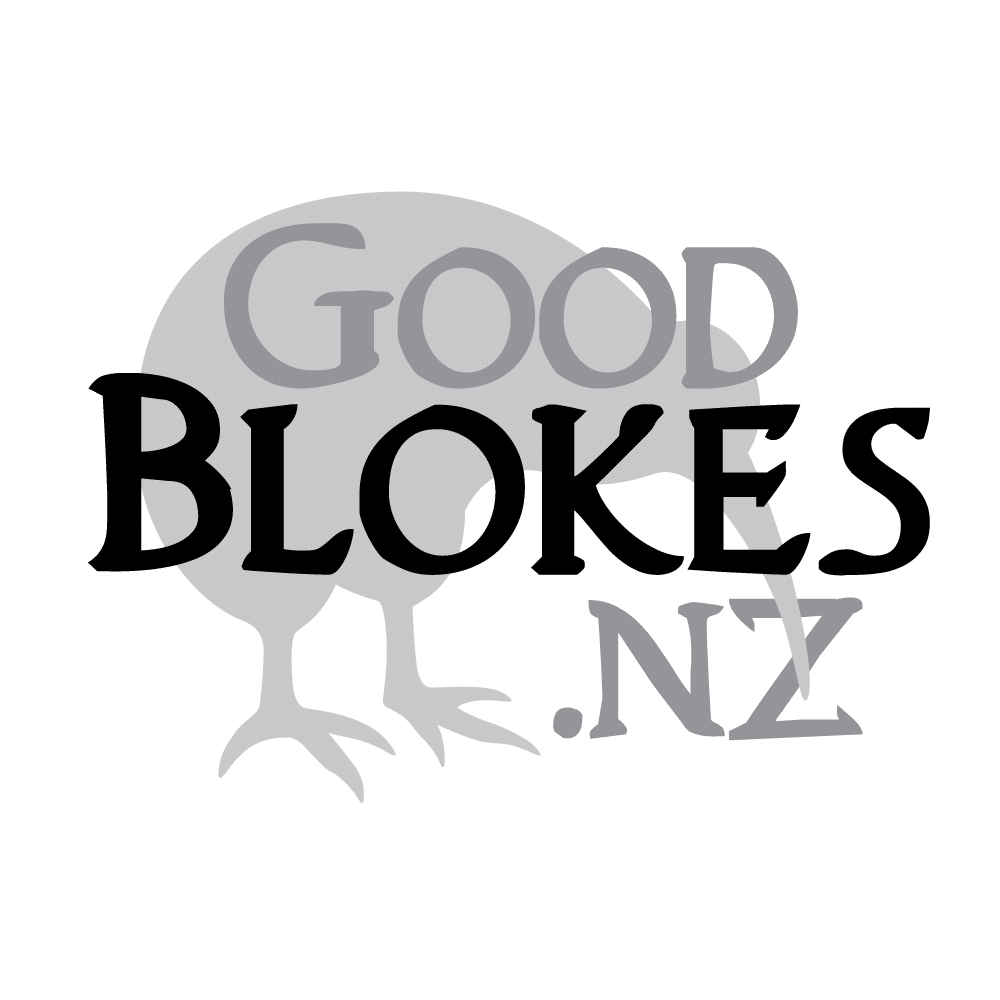Understanding the 7 basic rules

- Treat every firearm as loaded
- Always point firearms in a safe direction
- Load a firearm only when ready to fire
While all the rules are important, these are the three that care most directly applicable to the way we physically handle and manipulate a firearm.
Here is the simple truth – if a firearms user always follows the clearly laid out rules – there is no way that injury or death can occur – unless it is intentional. This holds true with a rifle, a shotgun or a pistol. No matter what country you are in, there is going to be some derivative of the above.
The mechanics of a firearm
For a firearm to discharge – a very specific, interdependent sequence of events needs to happen. A firearm needs to have it’s action fully functional, it needs to have live ammunition in the chamber, the firing pin needs to be ready to the the primer with force, the safety systems need to be off and the user needs to depress the trigger, causing the firearm to go through it’s firing sequence and causing the primer to ignite the powder which in turn creates the pressure required to expel the projectile from the end of the barrel.
If one of these processes is removed from the sequence a firearm cannot fire. On the assumption you have a correctly functioning firearm (and not maintaining it that way is negligence); If there is no bolt in a firearm, it can’t fire. If there is no ammo in the firearm, it can’t fire, if there the trigger isn’t pressed, it can’t fire and if it isn’t pointing in the direction of someone, it can’t directly hit them.
How do the rules translate into firearms handling?
Trigger Control
As we have already covered – a firearm is not going to go off unless it is loaded and you pull the trigger (malfunctions withstanding). So keep that finger well away from the trigger until you are ready to fire.
This means should you get bumped, slip, cough or otherwise have that finger disturbed – the trigger can’t get depressed and the gun can’t go off. This is critical if you know there is a round in the chamber and still important even if you think there isn’t. Why? Habit.
The habitual position for your finger should be off the trigger. The only way you form this habit is by always doing it. If you have that finger on trigger, while goofing around and handling the firearm, you are programming your subconscious mind with a bad habit. Do you need the trigger on the finger? No. Then get it off it. Muscle memory is a powerful thing – I have watched people who are new to shooting putting their finger on the trigger after being told not too – because their conscious mind is busy trying to figure out things like loading the gun, aiming, breathing, their sub-conscious mind takes over the muscles and the finger ends up where it habitually wants to go – often on the trigger. We need to break that muscle memory associate through strict control.
 I don’t know why so many people pick up a gun and find their finger on the trigger – I guess it’s partially due to TV, where for a very long time that’s simply what was shown – for many people the only part of gun handling they have observed is the actual act of shooting – so it seems normally to pick up a gun and be ready to go. It’s only as people become more educated around the risks and the safe handling that we start to understand the need to keep our finger away from the trigger.
I don’t know why so many people pick up a gun and find their finger on the trigger – I guess it’s partially due to TV, where for a very long time that’s simply what was shown – for many people the only part of gun handling they have observed is the actual act of shooting – so it seems normally to pick up a gun and be ready to go. It’s only as people become more educated around the risks and the safe handling that we start to understand the need to keep our finger away from the trigger.
The only time your finger should be near the trigger is when you are on target (live or dry) and ready to go through the trigger pulling process.
Muzzle Control
Never point a gun at anything you are unwilling to destroy.
Despite what the movie might have told you, a bullet can’t bend mid flight.1 Sure, ricochets occur, but that’s another matter.2
If you are always are aware of where the muzzle is pointing and never point it towards anyone or anything that you are unwilling to shoot – then you start forming a habit that will keep you aware of your guns positioning at all times.
I have handed firearms to people (generally first timers) and been immediately swept by them. They don’t know any better – as they manipulate the firearm they are simply not yet always aware of the direction that the barrel is pointing in. As you develop more awareness, whether you are chamber checking, manipulating a bolt, adjusting the scope, at the same time, you are aware what the handling is doing in regards the the direction of the gun.
I am always immediately nervous about someone who waves a firearm around while talking, gesticulating with the gun. The muzzle control simply isn’t ingrained – as you are likely to get sweeped at some point. Does it mean they are definitely going to shoot you? No. Of course no, but the margin of error has just significantly decreased.
Why so paranoid?
A common observation that comes into play is this one – ‘but we know the gun is unloaded!’.
It may be the case that you are, in your head certain a firearm is unloaded. But people get that wrong. People have died getting that wrong. If a Navy Seal can get it wrong and shoot himself in the head. So can you. But then, how many rules did he break? In his case – two of the seven. He didn’t treat the firearm as loaded, regardless of what he thought it’s state was, and he didn’t point it in a safe direction.
Also – malfunctions happen. Though very, very rare, there is a mechanical capacity for a live round to remain in the chamber, even after you think you have removed all the ammo. That’s why when you unload a firearm, you don’t simply ’empty the chamber’ – you need to physically (through eyes and or fingers) check it’s empty. Don’t assume. Be paranoid.
However – let us assume for a moment you have a firearm that is actually loaded – maybe a round stuck, maybe you were just handed a gun that you have been told was empty but actually isn’t, there are multiple reasons this could happen. If we are following the basic safety rules, there is still no way someone can get injured.
How is that?
Well. Because you are treating every firearm as loaded, you aren’t going to be putting your finger anywhere near the trigger, unless you are on target and wanting to discharge the firearm. You aren’t going to be pointing the firearm at someone, including yourself because 1. you are treating it as loaded and 2. rule number 2. Finally, the next time you check the state of the firearm, you are going to realise it is still loaded, clear it, and feel like an idiot. Better to feel stupid than to injure someone.
Potential consequences demand it.
The results of something going wrong can be death. It is easy to blase about gun safety – but that can only be the case if you haven’t really accepted the responsibility of what can go wrong by doing so. People die. A healthy paranoia – a conscious hyper-awareness of our gun handling is required – because that provides us with an inbuilt margin of error when we get in a stressful situation.
A margin of error
Stress causes breakdowns in our better judgement. We all have momentary lapses of judgement.
Walking through the bush, if your ‘habit’ is being aware of where your muzzle is at all time, then you are going to be thinking about this as your walk around or over obstacles, push your way through scrub and generally make your way through uneven ground. If this is something you are blaise about normally, then that muzzle could end up pointing in all manner of directions – the most concerning of course being, directly at the person behind you.
However, say you do, momentarily sweep someone, while tripping on a root, sliding down a bank or one of the many other things that can and does happen out in the bush – well, because you have other habits in place – like not having a finger near the trigger, not having the firearm ready until ready to fire and utilising the safety features of your firearm, you still have a margin of error available to you that will ensure that nothing dangerous can happen.
What happens when we don’t have the proper habits instilled in ourselves is that we drastically reduce this safety margin around a negligent discharge. If we don’t have strict trigger discipline – we may find that our finger tends to creep towards the trigger as we get excited that there might be a big stag around the next corner. If we don’t have strict muzzle discipline, we might suddenly realise we have climbed up over a fallen tree and have our mate directly in line with a bullet.
It all in your attitude
Yeah, but I do have good trigger control most of the time!

The problem is, people develop a survivorship bias – that is, thinking along the lines of ‘well I have always done it this way and never had an issue, so I don’t need to change anything’. Let’s be clear here. You only need to have an incident once for the repercussions to be permanent. People get away with plenty before the final incident that catches them out.
How do I learn them?
Join a range and go practice
If the only time you pick up the rifle is to go out hunting, you have an issue. You need time with a firearm without the additional stress of actively hunting to become familiar with the firearm and to install safe habits while handling it. Nothing beats having someone else calling you out (or the perceived embarrassment of someone calling you out) to start the process of a healthy paranoia about firearms handling.
A range allows you to focus on the handling and shooting of a firearm – habitually going through the process until it becomes second nature.
Totally apart from the marksmanship advantages practising your shooting gives you, it means you are also handling a gun around other people – which encourages responsibility.
This is not to say everyone at a range has safe handling. I find there is two groups – the new and the ‘experienced’ that need to be watched. The ‘experienced’ simply means someone has been doing something for a long time. Not necessarily the right way. The old fellas are also known to become complacent – and next thing you know, you have someone waving around a rifle, sweeping the entire firing line.
Dryfire
Work on the sequence of events that come into play when firing. Remember to start with the finger off the trigger. Get on target. Take off the safety. Take a breath. Confirm the target. Let the finger come down onto the trigger. Take another breath. Confirm the target again. Squeeze the trigger.
Define your sequence and repeat it intentionally. Notice the finger does not go near the trigger until the firearm is already pointing in the right direction? You don’t mount the firearm and put a finger on the trigger. Intentionally place the step later in the sequence. Break the sequence early – so the mount the firearm, breath, but don’t go to shoot – all the time without the finger near the trigger.
These drills train the brain (and the finger) not to go near the trigger unless it’s a conscious decision. This is what we want.
I am not telling you to never press the trigger if not actually shooting the gun at a target – much the opposite. The more you practise making the act of pressing the trigger a deliberate act – not something done loosely, not something done unconsciously.
Compete!
I am sure this will ruffle some feathers – but I am going to suggest, that the majority of competitive shooters in NZ are going to have better gun safety habits than hunters (there are always exceptions – no doubt). It’s a combination of culture and familiarity with firearms.
If you want to instill some good safety habits – just get your B endorsement – on average that requires six months to do – as there is a large amount of training and competition required before an instructor will sign off on your application. Handling, moving, transitioning – it’s all covered and it’s all applicable to all firearms. Especially as more people are getting into utilising the AR style Semi-Automatic platform for hunting. You shouldn’t really be going out hunting until you have good gun handling habits and you certainly shouldn’t be looking at semi-automatics before you have very strict trigger discipline.
It’s all good! Just relax!
If we don’t habitually unload and carefully place our rifle on the other side of a fenceline before climbing over, we may shot and kill ourselves.3
If we don’t unload the firearm once the hunted animal is down, leave the safety off, then slip, we may shot and kill ourselves.4
If we aren’t aware of where our muzzle is pointing while doing something as ‘simple’ seeming as unloading a firearm, we might have a negligent discharge and shoot and kill an eleven year old child.5
Take self responsibility and hold others accountable.
If you get pulled up for poor firearms handling – don’t dismiss it. Don’t point out that other times where you did have gun safety and don’t ‘take it into consideration’ next time. You messed up. Be a man, admit it, try to understand what and why and don’t do it again.
If you see someone with poor gun safety – pull them up on it. They potentially don’t realise or know. Hopefully they will acknowledge and own the mistake and thank you for correcting them. If they are arrogant enough to dismiss you – make sure you stay away from them and point out the issues to others – because they are a safety risk. It’s not worth risking your own safety or that of others out of fear of offending someone. No matter who they are.
Certain things, like the half cock / safety / bolt open or closed situation are still up for debate. Things like trigger control and muzzle awareness are not. Standard practise, best practise, safe practise.
For an alternative take – here is an US take on firearms safety protocol
- All guns are always loaded.
- Never point a gun at anything you are unwilling to destroy.
- Keep your finger off the trigger until you are ready to fire.
- Know your target.
- Keep your gun at the minimum level of readiness.
arc yes, bend no ↩
5. Check your firing zone ↩
http://www.stuff.co.nz/national/68444230/deer-hunter-dies-after-shot-to-chest ↩
http://gisborneherald.co.nz/localnews/1975590-135/fatally-shot-hunter-from-te-kaha ↩
http://www.stuff.co.nz/national/72919626/Boy-11-dies-in-hunting-incident-in-Kaingaroa-forest ↩


